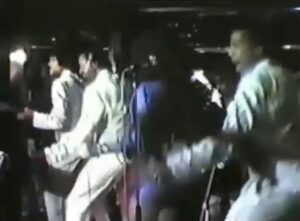Performing in Japan brings back many fond memories. During the 80’s, “A Touch Of Fire” probably performed there a least a dozen times or more; Adding up the years would easily total over four. On this occasion we were working at Pepe Le Moco, a club located in the upscale district of Akasaka. Akasaka is one of several districts which comprise the city of Tokyo. This was our second time working there and it was just as exciting as it had been on our previous trip. The first time was with the “Gomillione” band. Gomillione is actually the band that A Touch of Fire was patterned after. It proved to be a winning combinations.
Pepe Le Moco was a hostess club where men would pay to talk and drink with beautiful ladies. Hostess clubs in Japan are a very popular choice for many Japanese men who want to have a pleasant night out. Upon entering the club they would be greeted by a male staff member and then escorted to a table. Once seated, they would order their drink and, if so desired, request a female companion. Like most hostess clubs in Japan, Pepe Le Moco was very expensive, usually costing their customers hundreds if not thousands of dollars per visit. The club didn’t necessarily need to pack the house every night to have a profitable evening. As few as ten customers could satisfy their night’s quota. With as many as twenty hostesses working at any given time, Pepe Le Moco never had a dull night, and always appeared to be busy.
Performing between our shows was a four-piece Italian band named Silvio, which was also the name of their bandleader and lead vocalist. All the members in Silvio’s band had Japanese wives and lived in Japan fulltime. We knew Silvio and his band as we performed together on our previous trip to Pepe’s with the Gomillione band. This time felt more like a reunion: old friends meeting and working together again. As with Gomillione, we provided the danceable R&B style of music while Silvio specialized in a diverse mix of contemporary and classical music. Together we were a perfect fit for the club.

It was non-stop music from the time the club opened until it closed. A slow speed version of the classic song “Misty” would bridge the music between the two bands. It was the last song played at the end of each show. Playing Misty was the que for the band on break to go to the stage. Like runners passing the baton, the band on stage would continue playing Misty until their counterpart took over: making the music a seamless transition from one band to the other.
Of all the hostess club in Japan, Pepe Le Moco was among the most popular, particularly with Japanese men who worked for big companies. Most often it was their companies that picked-up the tab. Pepe Le Moco was also very popular with members of the Japanese mafia, aka Yakuza. In fact it was one of their favorite meeting places. Generally speaking Pepe’s customers were generous tippers. They showed their appreciation for the music with their wallets. Usually a 10,000 yen note, approximately 70 US dollars for every member in the band. The Yakuza were particularly known for their generosity as they sought to impress the band, the ladies, and most of all, each other. Unfortunately, due to YouTube copyright restrictions, I had to remove the live audio from the video. The replacement music was taken from Touch of Fire’s album.








